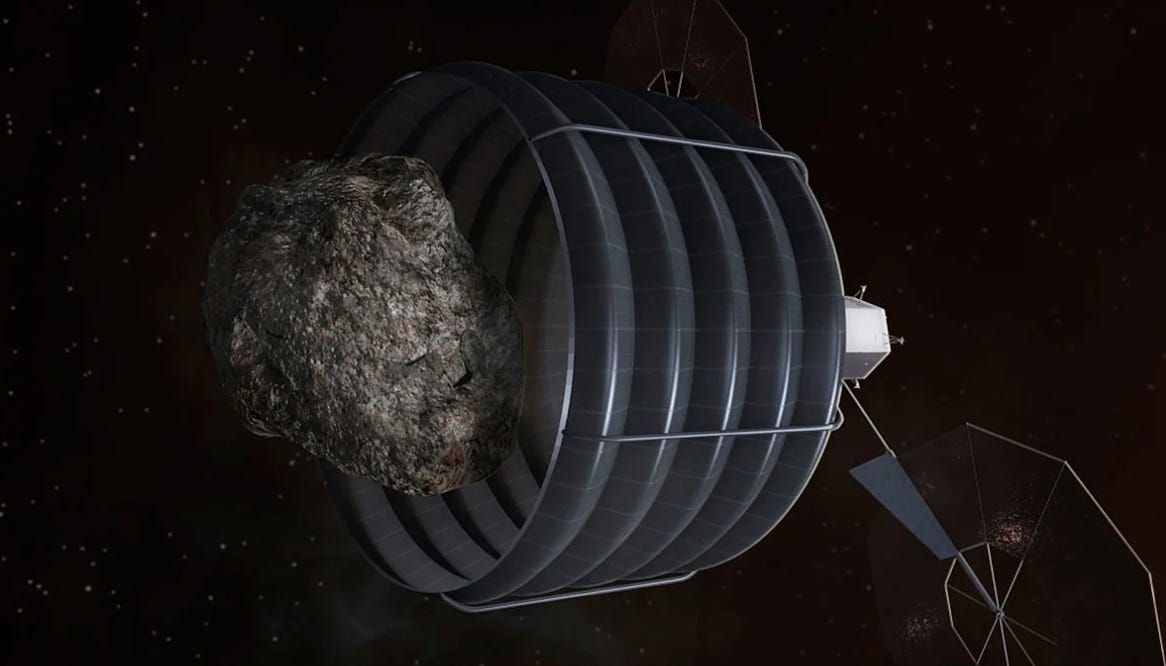The New Gold Rush: Asteroid Mining
Space mining has been a subject of fascination for decades with the idea that space resources will become a solution to the limited supply of non-renewable resources. How far we are on this journey?
The Oregon Trail: Space Edition
One of the early mentions of space mining appeared in a book called “Edison’s Conquest of Mars” written by Garrett P. Serviss in the late 19th century, in which Thomas Edison leads a group of scientists to develop weapons and spaceships for the defense of Earth from aliens, and at some point discovers that aliens mine asteroids for gold. To this day, space mining remains a staple of science fiction and is commonly associated with galvanizing amounts of resources that, if extracted, can erase any concerns of resource scarcity and lower the costs of space exploration missions. Asterank maintains a database of known asteroids in our solar system and some of the asteroids are reportedly worth more than $100T…
When looking at use cases on Earth, space mining can be economically viable only if we mine resources with a high value to mass ratio e.g. potentially rare Earth materials that are crucial for certain high-tech technologies like fuel cells and high-capacity batteries. It has been estimated that many of the elements we depend on could be exhausted in the next ~100 years: e.g., platinum, cobalt, iridium, and palladium. The estimate varies, and some forecasts indicate a more immediate threat. However, the first resource mined will likely be water, which can then be used by astronauts for drinking, H2O2 production for rocket fuel, and even space agriculture or in-orbit scientific research.
Use cases everywhere
Notably, there’s a myriad of proposed use cases for space-mined resources other than space agriculture and in-orbit research. The ability to collect, process, store, and use extracted space resources from asteroids, Mars, or the Moon is called in-situ resource utilization (ISRU). ISRU can provide construction materials for settlements on Mars, enable oxygen production from the oxides on the Moon for life support, and propel deep space exploration by making many critical supplies available like helium-3 that can potentially power spaceships. The return of the Artemis program to the Moon will further advance our knowledge of ISRU and the opportunities that it presents. The European Space Agency (ESA) forecasts that by 2030 we will be able to identify at least one deposit of ice and demonstrate oxygen production on the Moon.
But why do we need to mine asteroids?
If at this point you are wondering why we need asteroid mining at all, although we can potentially set up mining operations on the Moon, you are asking the right question. The scientific community is still split down the middle on this matter. On the one hand, the Moon is better understood, offers shorter communication delays, and often requires less time for transportation or repairs. On the other hand, asteroids offer a potentially more diverse pool of resources, require smaller missions that don’t need as much fuel, and asteroid mining missions can benefit from continuous solar power. From a legal perspective, the jury’s still out. In 2020, the Trump administration signed an executive order that formally recognized the rights of private companies to claim resources in space. Ultimately, a major deciding factor will be the venture’s bottom line and neither option is economically viable yet.
Whichever option we will gravitate towards in the future, space mining will likely commence with near-Earth asteroids (NEA). Despite the fact that the majority of research has been conducted on the accessibility of main belt asteroids due to the sheer number of them (>450,000), the long distance from Earth and necessary energy consumption make them less appealing targets. Although NEAs are farther away than the Moon, some of them can be reached using less energy. Moreover, it is technically possible to tow them closer to Earth for mining, and NEAs have an Earth-like orbit which makes them more accessible in terms of the equipment that is necessary for mining on their surface. It is estimated that there are currently over 20,000 known NEAs, and scientists have already identified suitable asteroids for mining water, PGMs, and other resources
Ninety nine problems but funding ain’t one
Launching asteroid mining operations comes with a bouquet of technical and financial issues: equipment resilience to extreme temperature swings and radiation, in-situ propellant production, optimization of travel trajectories, cost-risk analysis, mining throughput rate, the accuracy of remote prospecting, in-space storage - to name a few. Developing something as simple and reliable as shovels and drills, yet for asteroid mining, would be a good start. Planetary Resources and Deep Space Industries attempted to pioneer asteroid mining a decade ago but the timing was poor: the former was sold to a blockchain investor, while the latter pivoted towards smallsats and was later acquired by Bradford Space. By the way, Planetary’s mission was so enthralling that it motivated one of our team members to quit banking and join a venture capital firm that was one of its early backers, along with Richard Branson, Eric Schmidt, and Larry Page.
A new wave of asteroid mining companies has emerged over the last few years. Transastra, a US-based space mining startup, has raised roughly $7M since 2019 to develop a 250 kg space vehicle to capture small asteroids and use thermal mining to vaporize the water and condense the water vapor into storage containers. The team also develops space tugs for satellites and propulsion systems that use concentrated sunlight as the energy source. OffWorld, a US-based company, has landed more than $4M from investors since 2021 to develop autonomous mining robots for Earth, Moon, Mars, and asteroid applications with machine learning capabilities; the robots can be configured for various types of tasks. The idea is that large numbers of smaller redundant robots protect against failures by offering many spares. The optimal architecture for asteroid mining missions must maximize flexibility, redundancy, and capacity for self-correction, as well as minimizing human risk. Robotic services therefore, will be crucial for asteroid mining, whether they are completely autonomous or teleoperated from Earth. AstroForge raised a $13M Seed funding this year to mine an asteroid by 2030. The founders claim they’ve found a way to refine materials in-space but are reluctant to disclose any details. Origin Space, a Beijing-based space startup, launched its first “space mining robot” in November. Although the vehicle won’t be mining any asteroids, it will test various important functions like orbital maneuvers, simulated small celestial body capture, and intelligent spacecraft identification.
Space agencies aren’t ready to leap yet
For the time being, scientific sampling missions remain the primary focus of space agencies. The Japanese mission Hayabusa2 (2014) recently returned a sample from Ryugu, an asteroid that likely formed at the outer edge of the Solar System. The mission was similar in design to Hayabusa (2003) but the second one carried an impactor which created a crater and exposed resources which were collected and returned to Earth for analysis. In 2007, NASA sent a mission to rendezvous and orbit a couple of asteroids in order to characterize the asteroids’ internal structure, density, shape, size, composition, and mass. NASA’s OSIRIS-REx (2016) mission successfully collected a sample of material from a near-Earth carbonaceous asteroid Bennu a couple of years ago and should return to Earth in 2023. In 2021, NASA initiated a flyby mission named Lucy to make observations of eight asteroids orbiting Jupiter. Earlier this year, NASA’s Double Asteroid Redirection Test (DART) spacecraft intentionally slammed into an asteroid to test whether the approach is sound against the actually dangerous ones. These are just a few examples.
What are we waiting for?
Although it’s probably too early to sound the alarm, we are running out of rare Earth resources, and the next generation might not be so lucky. There’s an abundance of problems associated with asteroid mining but that means there’s plenty of headroom for innovation and opportunities for entrepreneurs. Asteroid mining does seem like an unattainable milestone at the moment but it is coming soon, and the first trillionaire will most definitely be a space miner. If pessimistic principles were the underlying philosophy of spacetech, mankind would never have dared to venture into the New Frontier. If you’d like to discuss this further, please comment below or reach out to alexandra@spaceambiton.org











Thanks for the article. Sounds a bit futuristic:) do you by any chance know what is the underlying trend that pushed the second wave of asteroid mining in 2021? I saw many articles with regards to this topic:)